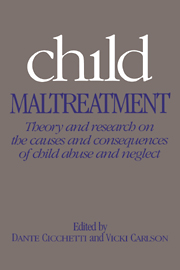Book contents
- Frontmatter
- Contents
- List of contributors
- Preface
- Part I History and definition
- Part II Parental and contextual influences on maltreatment
- Part III The developmental consequences of child maltreatment
- 13 How research on child maltreatment has informed the study of child development: perspectives from developmental psychopathology
- 14 Child maltreatment and attachment theory
- 15 Patterns of maternal behavior among infants at risk for abuse: relations with infant attachment behavior and infant development at 12 months of age
- 16 Finding order in disorganization: lessons from research on maltreated infants' attachments to their caregivers
- 17 Peer relations in maltreated children
- 18 The effects of maltreatment on development during early childhood: recent studies and their theoretical, clinical, and policy implications
- 19 Social cognition in maltreated children
- 20 The effects of maltreatment on the development of young children
- 21 Troubled youth, troubled families: the dynamics of adolescent maltreatment
- 22 Child abuse, delinquency, and violent criminality
- 23 The prevention of maltreatment
- Name index
- Subject index
16 - Finding order in disorganization: lessons from research on maltreated infants' attachments to their caregivers
Published online by Cambridge University Press: 04 May 2010
- Frontmatter
- Contents
- List of contributors
- Preface
- Part I History and definition
- Part II Parental and contextual influences on maltreatment
- Part III The developmental consequences of child maltreatment
- 13 How research on child maltreatment has informed the study of child development: perspectives from developmental psychopathology
- 14 Child maltreatment and attachment theory
- 15 Patterns of maternal behavior among infants at risk for abuse: relations with infant attachment behavior and infant development at 12 months of age
- 16 Finding order in disorganization: lessons from research on maltreated infants' attachments to their caregivers
- 17 Peer relations in maltreated children
- 18 The effects of maltreatment on development during early childhood: recent studies and their theoretical, clinical, and policy implications
- 19 Social cognition in maltreated children
- 20 The effects of maltreatment on the development of young children
- 21 Troubled youth, troubled families: the dynamics of adolescent maltreatment
- 22 Child abuse, delinquency, and violent criminality
- 23 The prevention of maltreatment
- Name index
- Subject index
Summary
There is more to be learnt from the study of disarray than is gained by intentionally disregarding it.
Although Bowlby's original formulations on attachment emerged from observations of clinical populations (Bowlby, 1944, 1958, 1977a, 1977b; Rutter, 1979), until recently we possessed only rudimentary empirical information regarding attachment relationships in clinically disordered populations. However, during the past decade, as research in the discipline of developmental psychopathology has burgeoned (cf. Cicchetti, 1984a, 1984b; Rolf, Masten, Cicchetti, Neuchterlein, and Weintraub, in press; Rutter & Garmezy, 1983), increased attention has been paid toward understanding the organization of the attachment system in handicapped, “high-risk” and clinically disordered groups of youngsters (see, for example, Cicchetti and Serafica, 1981; Crittenden, 1988; Egeland and Sroufe, 1981a, 1981b; Radke-Yarrow, Cummings, Kuczynski, and Chapman, 1985; Sigman and Ungerer, 1984).
Proponents of attachment theory have argued that many psychopathological disorders may be brought about by deviations in the development of the attachment behavioral system or, much less commonly, by failure of its ontogenesis (Ainsworth, 1973, 1980; Bowlby, 1969/1982, 1977a, 1977b; Cic-chetti, 1987; Guidano and Liotti, 1983). Additionally, advocates of the attachment theory perspective have stated that strong causal relationships exist between children's experiences with their caregivers and their later capacities to develop secure affectional bonds (Bowlby, 1944, 1977a, 1977b; Sroufe and Fleeson, 1986). Because the study of risk conditions from a developmental perspective is believed to augment our understanding of normal and abnormal forms of ontogenesis (Cicchetti, in press; Cicchetti, Cummings, Greenberg, and Marvin, in press), we think that the study of attachment in maltreated infants can make significant contributions to our knowledge about relationship formation and dissolution.
Information
- Type
- Chapter
- Information
- Child MaltreatmentTheory and Research on the Causes and Consequences of Child Abuse and Neglect, pp. 494 - 528Publisher: Cambridge University PressPrint publication year: 1989
Accessibility standard: Unknown
- 98
- Cited by
